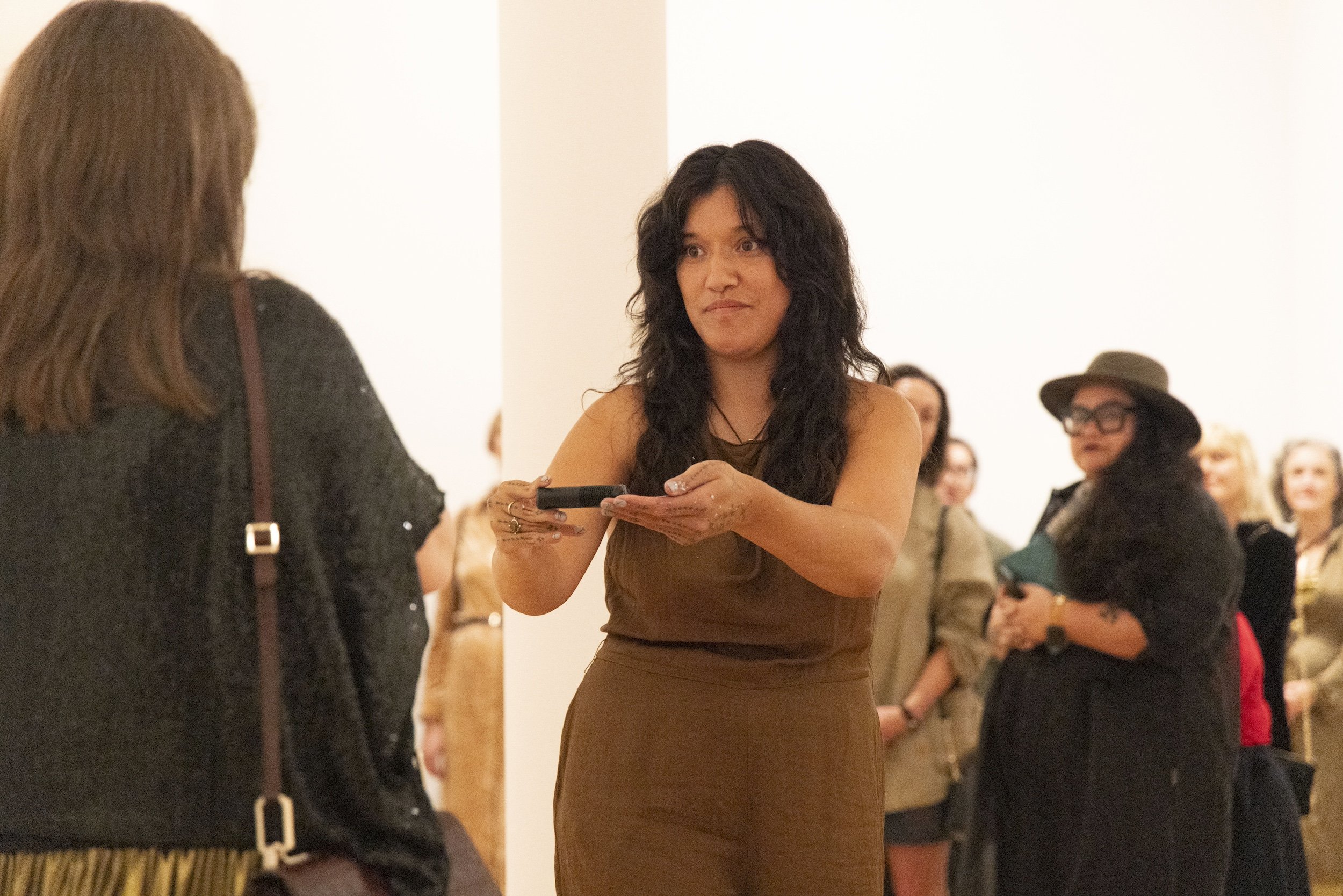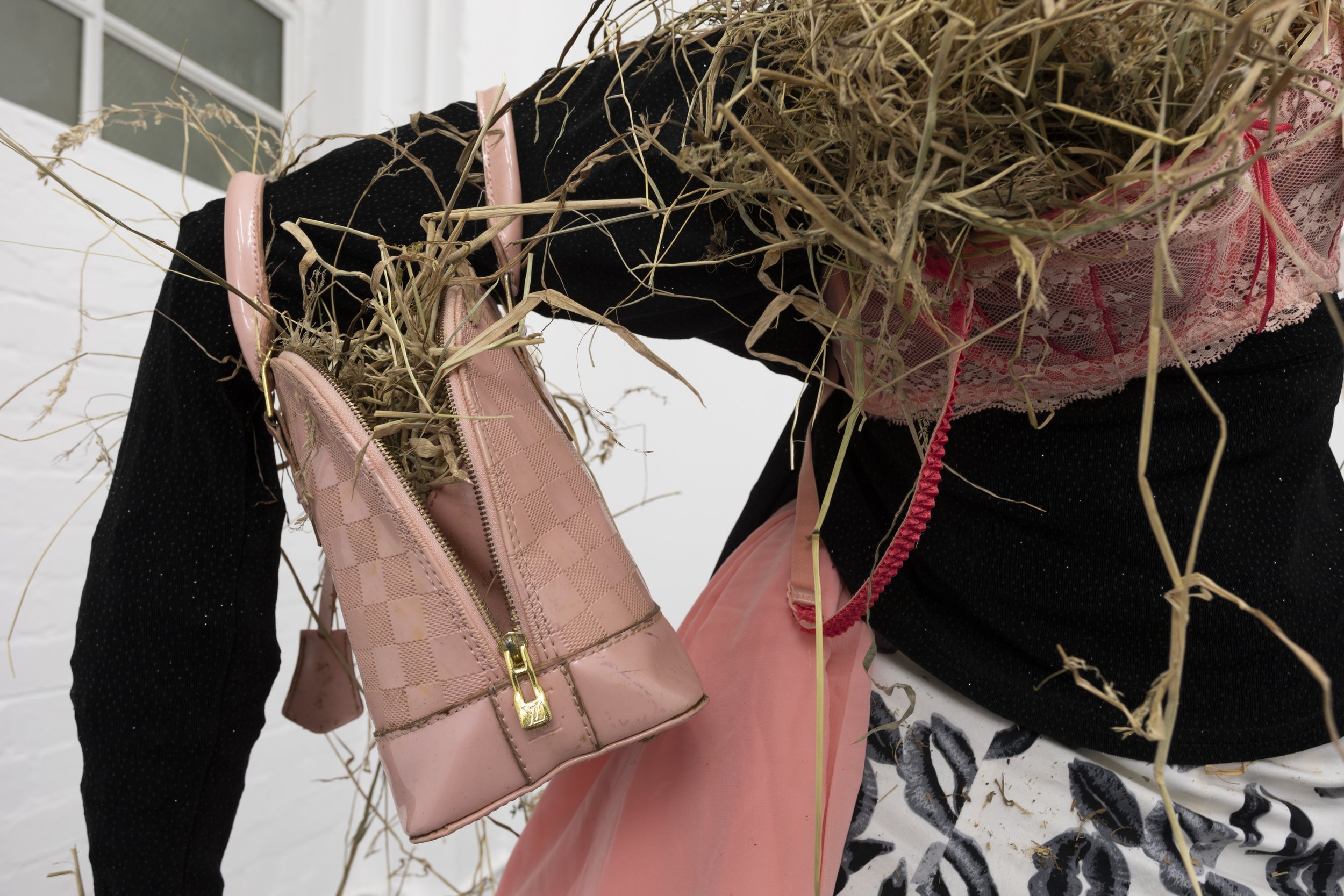“A Book from a Friend I Don’t Speak to Anymore”
The artworks in Isabella Dampney’s A Child of Divorce combine auto-fictional painting and social critique to respond to events and objects in her life that she finds absurd, synchronous, sad, or morally suspect. These paintings and drawings produce a personal archive with connections that are simultaneously contradictory and synchronous: “Through the partial fictionality of the works, I critique my experiences with social alienation, low-wage precarious employment, and the dysfunction of family relationships and friendships. The inconsistent nature of autofiction allows me to express the material of my life with distance. I emphasise absurd moments to critique my experiences of unmet social expectations— and use text and titling to foreground interpersonal tension as a subject of investigation.”
We talk to Isabella Dampney on the occasion of her recent presentation titled A Child of Divorce at ST PAUL St Gallery as part of the Master of Visual Arts Graduating Exhibition.
Portrait photography: Paul Chapman
Artwork photography: Isabella Dampney
Isabella Dampney with her painting La Mano, ST PAUL St Gallery, Tāmaki Makaurau, June 2023
Isabella Dampney, The Family That Reads Together, Leads Together (detail), 2023, oil on canvas, 135 x 75 cm
The works are hung like a frieze that begins with a flashy, slickly painted canvas: DIVORCE. Is this the story of your own family, or somebody fictional?
Each of the works in the exhibition stems from a personal experience, although these experiences are often exaggerated to the point that they might as well be entirely fabricated. I want to challenge my position as a reliable voice. The painting Family Meetings Never Go Well, the “DIVORCE” painting, is specific, because I am the Child of Divorce, and generic, because ultimately it’s just the word DIVORCE. I painted the word in red on a green background to mimic the tones of red-green colourblindness, which affects 8% of men, so 8% of dads. My dad isn’t colour blind, but if he was he’d just see a grey rectangle.
It's called Family Meetings Never Go Well because family meetings invariably lead to the disclosure of divorce, cancer, or death. And for me, our family meeting before my parents’ divorce became my dominant memory from that time in my life.
I met your parents at the opening. I kept thinking, which one was into Robert Kiyosaki? I’m assuming it was your dad because my dad was also very into him post-divorce.
I hadn't thought much about Rich Dad Poor Dad until I was travelling with my Dad in Morocco a few years ago, and we came across a stall exclusively selling it in different language editions. There were probably thirty copies. My family got our copy around the time it came out, so we had it for a decade pre-divorce. Everyone in my family had read it except me, until recently. Stapled in the back of the book is a Robert Kiyosaki profile from The Listener, which my mum cut out and hand dated 17-10-1998.
Did you ever play Ca$hflow? It was like Monopoly but with debts and unexpected children and shares and businesses. It was all wrapped up within a couple of hours though, so there wasn’t time to get anxious and behind.
I’m actually already working on a series of paintings about Cashflow. I’m kind of the Robert Kiyosaki artist. As part of an exhibition at Chez Derriere in Parnell, I’ll be running a couple of events in July where we play Cashflow and discuss our families’ relationships with personal finance. Since working on The Family That Reads Together, Leads Together, I've been thinking about how a family's financial narrative shapes the family narrative as a whole. The board game is very expensive, and I got into a Trade Me bidding war to secure my copy.
Why do you think divorced dads discover self-help and finance gurus?
Probably because their self-worth is tied into their financial wellbeing, and they’ve just had their finances split in half. Along with the failure of the marriage, they’ve failed the expectations they set for themselves, and I imagine there must be a sense of urgency to try and regain the financial foothold they had pre-divorce.
Rich Dad Poor Dad is really marketed towards men around their role as the primary breadwinner. “My poor dad would say, ‘I’m not interested in money’. My rich dad always said, ‘money is power.” The book makes an explicit link between masculinity and societal esteem, and I think preying on this vulnerability was key to the Robert Kiyosaki’s success.
Isabella Dampney with her painting Breaking News, ST PAUL St Gallery, Tāmaki Makaurau, June 2023
There are also a few religiously-imbued references—stigmata and La Mano, a hand with curled fingers that is very Christ-like. Where did these come from?
I didn’t grow up religious, and both of these paintings come from very different experiences. The painting A Gift From a Friend I Don't Speak to Anymore replicates the book La Mano, a collection of hands from the Musée d'Orsay. With Breaking News, I wanted to suggest a martyrdom to the figure, hence the stigmata, leaning into an idea that divorce is a chosen path of conviction that leads to ostracisation.I agree that there is a religious overtone, I think I co-opted it to bring a sense of weight and ceremony to the subjects.
What about the sad turtle chained up?
Animals often feature as subjects in my paintings, generally in relation to cruelty. My Host Parents Had a Pet Turtle is a painting of a turtle that lived outside in rural Argentina through the dry summers and snowy winters. I encountered the pet on an exchange trip. My host family and young cousins were eager to show him off to me and play with him, but I found the chain drilled into its shell confronting. I’m interested in animals because I think my feelings about them are really culturally inherited, but they’re also so deeply felt.
I can’t imagine putting a chain through a turtle’s shell, but my host family had no problem with it. It’s a practical solution to the problem of your turtle running away.
Is there anything else you’d like to write about this presentation?
According to a website I read, Stevie Wonder is red-green colourblind.
Isabella Dampney, Family Meetings Never Go Well, 2023, oil on canvas, 40 x 60 cm
Isabella Dampney, The Family That Reads Together, Leads Together, 2023, oil on canvas, 135 x 75 cm
Isabella Dampney, A Book from a Friend I Don’t Speak to Anymore, oil and graphite on canvas, 30 x 35 cm; My Host Parents Had a Pet Turtle, 2023, oil and charcoal on canvas, 35 x 50 cm
Isabella Dampney, Google Maps Still Life, Cafe Where I Worked, 2022, charcoal and print paste screen-print, 70 x 100 cm
Isabella Dampney, A Child of Divorce. Installation view, ST PAUL St Gallery, Tāmaki Makaurau, June 2023
















